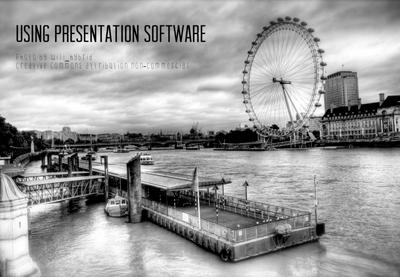Active Learning
35 Active Learning in Large Lecture Courses
 Observe & Consider
Observe & Consider
The Large Lecture and Its Challenges
As Bill Costello, our guest undergraduate turned art teacher, shared with us in last week’s video, a common student perspective is that the typical undergraduate class “mainly consists of the professor getting up on the stage and giving variations on a PowerPoint.” This perception isn’t just shared by undergraduates either. In fact, in a 2008 survey of UW-Madison instructors conducted by DoIT Academic Technology, more than two-thirds of all respondents chose “Making lecture more interactive and engaging” as their number one teaching challenge from a list of 15 choices. In 2010, more than half (53%) of all respondents listed ”Making lecture more interactive and engaging” as their top teaching challenge, with another quarter (24%) of respondents listing “Providing students with practice or reinforcement” as their top challenge. It’s clear that both students and faculty are interested in injecting active learning activities and approaches into the traditional lecture, but it’s not always as clear how to best do this.
“Getting up on the Stage”: Making Lectures More Interactive and Engaging

Before we begin exploring specific practical ideas for reconfiguring the lecture, we want to stress that we don’t believe that lecturing itself is inhospitable to active learning. In this week’s podcast, you’ll even hear David Zimmerman offer a defense of what he calls “the humble lecture.” Students can (and do) learn from lecturing, and if you teach a course where lecturing plays an indispensible role in accomplishing your course goals, it’s important to prepare and deliver quality lectures, and to perform them in ways that fit your own personality and teaching style. It can also help to review some of what we do know about effective lectures. We believe that most effective lectures share a few common features, including the following:
- Variety: Most effective lecturers use a variety of instructional strategies and materials on different days and within a given lecture. This also applies to your own presentation style: as you vary the speed, the loudness, and the tone of your voice you send signals about the relative importance of different material in each lecture.
- Visual Engagement: Carefully selected visuals (whether projected or produced verbally through descriptive language and evocative storytelling) can help focus students’ attention and reinforce lecture material. This principle also applies to how you establish and use eye contact and move through classroom space: consider dividing the room up into four sections and practice periodically directing your attention to each of the sections as you lecture. In now infamous studies of how we communicate our feelings (which became the source of the oft-quoted 7-38-55 rule), Albert Mehrabian found that listeners perceive our body language and vocal delivery as far more important indicators of our emotional state than the words we say.
- Personal Relevance: Students learn best when they are asked to provide personal insights and interpretations. Tell stories (from your own life or from literature or history) which help illustrate your lecture’s content or provide a memorable hook for abstract ideas. You can promote real-world application by starting a segment of your lecture with a real-world problem and then working backward to the concepts, formulas, solutions, or application of knowledge which help resolve it.
- Clarity, simplicity, organization: Share your daily objectives and lecture outline at the outset of your lecture and clearly signal when you move from one segment of your lecture to another. When incorporating a class activity, build in opportunities for reflection on the activity’s purpose and the learning objectives it supported.
In addition to these key features, there are a number of other suggestions in the literature for revitalizing or reinvigorating the traditional lecture. While we obviously can’t share all of them with you, here are two helpful sources we do recommend:
- In 2009, DoIT AT and the UW Teaching Academy partnered to host an event that addressed the instructor survey described in this section’s opening paragraph by introducing the idea of “threshold concepts” and listing several methods for incorporating these into lecture courses. We’ve made a brief 2 page handout based on their presentation materials.
- In 1996, the well-regarded teacher and historian Charles Bonwell published a short article called “Enhancing the Lecture: Revitalizing a Traditional Format.” It’s pretty much what it sounds like from the title.
“Giving Variations on a PowerPoint”: Using Presentation Software

While some lecturers prefer to speak directly to their classes without technological intervention, many teachers use presentation software to help them execute their lecture plans. The most ubiquitous in college classrooms (for good or for ill) is still Microsoft’s PowerPoint, though there are number of competitors or similar products, including Apple’s Keynote and the free web-based presentation tool Prezi.
Each of these tools has their own strengths and weaknesses, and while any of them can become a crutch for a unprepared or disengaged presenter, they can also help presenters support their meaningful learning and serve as aids for active learning ideas. If you use presentation software in your lectures, and want some tips or ideas about improving its effectiveness, we’ve collected a few useful resources to help you get more out of your lectures:
- The University of Minnesota’s Center for Teaching and Learning has built really useful self-paced tutorials on “Active Learning with PowerPoint” “Designing Smart Lectures” and “Making Active Learning Work.” All three of these are detailed, practical, and very thorough resources.
- The University of Central Florida’s Center for Teaching & Learning has built a great page on the effective use of PowerPoint, complete with best practices, sample approaches, how-to guides, and curated resources.
- In February 2013, UW-Madison’s very own DesignLab hosted a fantastic workshop on improving your (and your students’) presentations. Here are the slides from that workshop (complete with best practices, tips, and campus resources).
- DesignLab consultants Kevin Gibbons and Dan Banda also made a concise, attractive two-page handout which encapsulates their big take-away ideas, compares leading presentation softwares, and lists best practices.
Now that we’ve discussed some of the ways of improving traditional lectures without abandoning the form itself, in the next chapter we’ll take a look at some of the specific problems that traditional lecturing poses in relation to student learning and explore some specific approaches to the large lecture class that incorporate active learning activities.
Media Attributions
- 3-modesB

